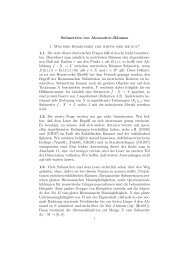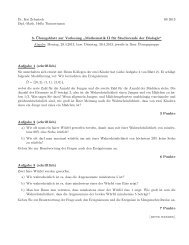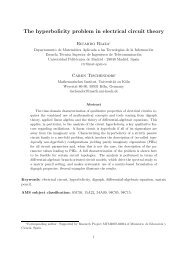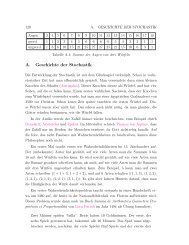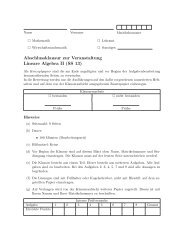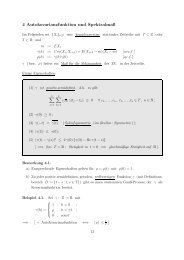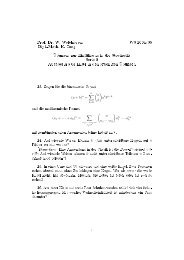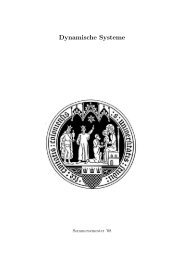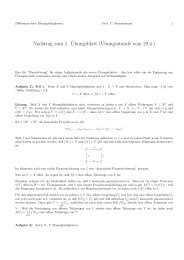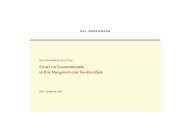Inhaltsverzeichnis - Mathematisches Institut der Universität zu Köln
Inhaltsverzeichnis - Mathematisches Institut der Universität zu Köln
Inhaltsverzeichnis - Mathematisches Institut der Universität zu Köln
You also want an ePaper? Increase the reach of your titles
YUMPU automatically turns print PDFs into web optimized ePapers that Google loves.
DMV Tagung 2011 - <strong>Köln</strong>, 19. - 22. September<br />
Sergey Tikhomirov, Sergey Kryzhevich<br />
Frei <strong>Universität</strong> Berlin, Saint-Petersburg State University<br />
Shadowing in Partially hyperbolic systems<br />
The shadowing problem is related to the following question: un<strong>der</strong> which condition, for any pseudotrajectory<br />
(approximate trajectory) of a diffeomorphism there exists a close exact trajectory. The most famous<br />
result in shadowing theory is so-called Shadowing Lemma: in a small neighborhood of a hyperbolic<br />
set near any pseudotrajectory there exists an exact trajectory. We prove analog of shadowing lemma<br />
for partially hyperbolic diffeomorphisms. Let f be a partially hyperbolic diffeomorphism with splitting<br />
E s ⊕ E c ⊕ E u . Let us assume that it is dynamically coherent with foliations W s , W c , W u . We say that<br />
sequence {xk} is a d-central pseudotrajectory if dist(xk+1, f (xk)) < d and xk+1 and f (xk) lies on the same<br />
central leaf. We proved that for any ε > 0 there exists d > 0 such that any d-pseudotrajectory {yn} can be<br />
ε shadowed by a ε-central pseudotrajectory.<br />
Martin Väth<br />
Freie <strong>Universität</strong> Berlin<br />
Reaktions-Diffusionssysteme mit einseitigen Hin<strong>der</strong>nissen<br />
Es ist bekannt, dass in einem Reaktions-Diffusionssystem die Diffusion durch den sog. Turing-Effekt<br />
für Instabilität sorgen und damit in vielen Systemen Musterbildung ermöglichen kann. Dennoch gibt es<br />
einen großen Bereich von Parametern, in dem das System trotz <strong>der</strong> Diffusion stabil ist. Im Vortrag wird<br />
diskutiert, weshalb einseitige Hin<strong>der</strong>nisse, etwa Quellen o<strong>der</strong> Senken, die erst ab einer gewissen Schwelle<br />
aktiv werden, auch in diesen Parameterbereichen für Bifurkation sorgen können. Ohne <strong>zu</strong>sätzliche<br />
Dirichlet-Randbedingungen war dieses Problem seit fast 30 Jahren offen.<br />
Glen Wheeler<br />
Otto-von-Guericke-<strong>Universität</strong> Magdeburg<br />
On the curve diffusion flow of planar curves<br />
The curve diffusion flow of a planar curve is the steepest descent gradient flow of the length functional<br />
in H −1 . We consi<strong>der</strong> the flow of periodic immersed curves with arbitrary winding number and discuss<br />
some recent new results on long time existence and exponential convergence for initial data with small<br />
‘oscillation of curvature’ and isoperimetric ratio close to that of a multiply-covered circle. We also provide<br />
an estimate for the measure of the time during which the curvature is not strictly positive, quantifying<br />
the extent of the failure of global positivity of curvature. Finally we compare this situation for curves<br />
with that of surfaces immersed in R 3 flowing by surface diffusion, and briefly discuss the new difficulties<br />
encountered there.<br />
64




